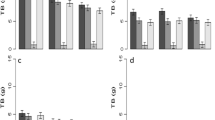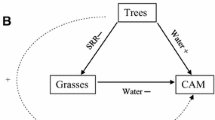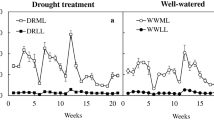Abstract
Abiotic drivers of environmental stress have been found to induce CAM expression (nocturnal carboxylation) in facultative CAM species such as Mesembryanthemum crystallinum. The role played by biotic factors such as competition with non-CAM species in affecting CAM expression, however, remains largely understudied. This research investigated the effects of salt and water conditions on the competition between M. crystallinum and the C3 grass Bromus mollis with which it is found to coexist in California’s coastal grasslands. We also investigated the extent to which CAM expression in M. crystallinum was affected by the intensity of the competition with B. mollis. We found that M. crystallinum had a competitive advantage over B. mollis in drought and saline conditions, while B. mollis exerted strong competitive effects on M. crystallinum in access to light and soil nutrients in high water conditions. This strong competitive effect even outweighed the favorable effects of salt or water additions in increasing the biomass and productivity of M. crystallinum in mixture. Regardless of salt conditions, M. crystallinum did not switch to CAM photosynthesis in response to this strong competitive effect from B. mollis. Disturbance (i.e., grass cutting) reduced the competitive pressure by B. mollis and allowed for CAM expression in M. crystallinum when it was grown mixed with B. mollis. We suggest that moderate competition with other functional groups can enhance CAM expression in M. crystallinum, thereby affecting its plasticity and ability to cope with biological stress.





Similar content being viewed by others
References
Adams P, Nelson DE, Yamada S, Chmara W, Jensen RG, Bohnert HJ, Griffiths H (1998) Growth and development of Mesembryanthemum crystallinum (Aizoaceae). New Phytol 138:171–190
Agarie S, Shimoda T, Shimizu Y, Baumann K, Sunagawa H, Kondo A, Ueno O, Nakahara T, Nose A, Cushman JC (2007) Salt tolerance, salt accumulation, and ionic homeostasis in an epidermal bladder-cell-less mutant of the common ice plant Mesembryanthemum crystallinum. J Exp Bot 58:1957–1967
Anderies JM, Janssen MA, Walker BH (2002) Grazing, management, resilience and the dynamics of fire-driven rangeland system. Ecosystems 5:23–44
Antony E, Borland AM (2008) The role and regulation of sugar transporters in plants with crassulacean acid metabolism. Prog Bot 70:127–143
Antony E, Taybi T, Courbot M, Mugford S, Smith JAC, Borland AM (2008) Cloning, localization and expression analysis of vacuolar sugar transporters in the CAM plant Ananas comosus (pineapple). J Exp Bot 59:1895–1908
Borland AM, Dodd AN (2002) Carbohydrate partitioning in crassulacean acid metabolism plants: reconciling potential conflicts of interest. Funct Plant Biol 29:707–716
Borland AM, Griffiths H, Hartwell J, Smith JAC (2009) Exploiting the potential of plants with crassulacean acid metabolism for bioenergy production on marginal lands. J Exp Bot 60:2879–2896
Borland AM, Barrera Zambrano VA, Ceusters J, Shorrock K (2011) The photosynthetic plasticity of crassulacean acid metabolism: an evolutionary innovation for sustainable productivity in a changing world. N Phytol 191:619–633
Charles H, Dukes JS (2009) Effects of warming and altered precipitation on plant and nutrient dynamics of a New England salt marsh. Ecol Appl 19:1758–1773
Collins SL, Xia Y (2015) Long-term dynamics and hotspots of change in a desert grassland plant community. Am Nat 185:E30–E43
Connell JH (1983) On the prevalence and relative importance of interspecific competition: evidence from field experiments. Am Nat 122:661–697
Cushman JC, Borland AM (2002) Induction of crassulacean acid metabolism by water limitation. Plant Cell Environ 25:295–310
Cushman JC, Agarie S, Albion RL, Elliot SM, Taybi T, Borland AM (2008) Isolation and characterization of mutants of common ice plant deficient in crassulacean acid metabolism. Plant Physiol 147:228–238
D’Antonio CM, Vitousek PM (1992) Biological invasions by exotic grasses, the grass/fire cycle, and global change. Annu Rev Ecol Evol Syst 23:63–87
D’Odorico P, Okin GS, Bestelmeyer BT (2012) A synthetic review of feedbacks and drivers of shrub encroachment in arid grasslands. Ecohydrology 5:520–530
Drennan PM, Nobel PS (2000) Responses of CAM species to increasing atmospheric CO2 concentrations. Plant Cell Environ 23:767–781
Easterling DR, Meehl GA, Parmesan C, Changnon SA, Karl TR, Mearns LO (2000) Climate extremes: observations, modeling and impacts. Science 289:2068–2074
Fay PA, Jin VL, Way DA, Potter KN, Gill RA, Jackson RB, Polley HW (2012) Soil-mediated effects of subambient to increased carbon dioxide on grassland productivity. Nat Clim Change 2:742–746
Haider MS, Barnes JD, Cushman JC, Borland AM (2012) A CAM- and starch-deficient mutant of the facultative CAM species Mesembryanthemum crystallinum reconciles sink demands by repartitioning carbon during acclimation to salinity. J Exp Bot 63:1985–1996
Held IM, Soden RJ (2006) Robust responses of the hydrological cycle to global warming. J Clim 19:5686–5699
Herppich WB, Huyskens-Keil S, Schreiner M (2008) Effects of saline irrigation on growth, physiology and quality of Mesembryanthemum crystallinum L., a rare vegetable crop. J Appl Bot Food Qual 82:47–54
Herrera A (2009) Crassulacean acid metabolism and fitness under water deficit stress: if not for carbon gain, what is facultative CAM good for? Ann Bot 103:645–653
Huxman TE, Monson RK (2003) Stomatal responses of C3, C3–C4, and C4 Flaveria species to light and intercellular CO2 concentration: implications for the evolution of stomatal behavior. Plant Cell Environ 26:313–322
Kulmatiski A, Beard KH (2013) Woody plant encroachment facilitated by increased precipitation intensity. Nat Clim Change 3:833–837
Kuzniak E, Kornas A, Gabara B, Ullrich C, Skłodowska M, Miszalski Z (2010) Interaction of Botrytis cinerea with the intermediate C3-CAM plant Mesembryanthemum crystallinum. Environ Exper Bot 69:137–147
Li HL, Yu KL, Ratajczak Z, Nippert J, Tondrob D, Xu DH, Li W, Du GZ (2016) When variability outperforms the mean: trait plasticity predicts plant performance in an alpine wetland. Plant Soil 407:401–415
LoPresti EF (2014) Chenopod salt bladders deter insect herbivores. Oecologia 174:921–930
Lüttge U (2004) Ecophysiology of crassulacean acid metabolism (CAM). Ann Bot 93:629–652
Lynn RJ, Simpson JJ (1987) The California current system: the seasonal variability of its physical characteristics. J Geophys Res 92:12947–12966
Maiquetía M, Caceres A, Herrera A (2009) Mycorrhization and phosphorus nutrition affect water relations and CAM induction by drought in seedlings of Clusia minor. Ann Bot 103:525–532
McCown RL, Williams WA (1968) Competition for nutrients and light between the annual grassland species Bromus Mollis and Erodium Botrys. Ecology 49:981–990
Morris JT, Sundareshwar PV, Nietch CT, Kjerfve B, Cahoon DR (2002) Responses of coastal wetlands to rising sea level. Ecology 83:2869–2877
Niu SL, Liu WX, Wan SQ (2008) Different growth response of C3 and C4 grasses to seasonal water and nitrogen regimes and competition in a pot experiment. J Exp Bot 59:1431–1439
Ogburn RM, Edwards EJ (2010) The ecological water-use strategies of succulent plants. Adv Bot Res 55:179–225
Oh D, Barkla B, Vera-Estrella R, Pantoja O, Lee S, Bohnert H et al (2015) Cell type-specific responses to salinity-the epidermal bladder cell transcriptome of Mesembryanthemum crystallinum. N Phytol 207:627–644
Osmond CB (1978) Crassulacean acid metabolism: a curiosity in context. Annu Rev Plant Physiol 29:379–414
Owen NA, Fahy KF, Griffiths H (2016) Crassulacean acid metabolism (CAM) offers sustainable bioenergy production and resilience to climate change. GCB Bioenergy 8:737–749
Ranson SL, Thomas M (1960) Crassulacean acid metabolism. Annu Rev Plant Physiol 11:81–110
Reyes-García C, Andrade JL (2009) Crassulacean acid metabolism under global climate change. N Phytol 181:754–757
Schmitt JM (1990) Rapid concentration changes of phosphoenolpyruvate carboxylase mRNA in detached leaves of Mesembryanthemum crystallinum L. in response to wilting and rehydration. Plant Cell Environ 13:845–850
Scholes RJ, Archer SR (1997) Tree-grass interactions in savannas. Annu Rev Ecol Evol Syst 28:517–544
Silvera K, Neubig KM, Whitten WM, Williams NH, Winter K, Cushman JC (2010) Evolution along the crassulacean acid metabolism continuum. Funct Plant Biol 37:995–1010
Sun XM, Yu KL, Shugart H, Wang G (2016) Species richness loss after nutrient additions as affected by N: C ratio and plant endogenous hormones in an alpine meadow. J Plant Ecol 9:201–211
Suttle KB, Thomsen MA, Power ME (2007) Species interactions reverse grassland responses to changing climate. Science 315:640–642
Teuling AJ, Senevirante SI, Stöckli R, Reichstein M, Moors E et al (2010) Contrasting response of European forest and grassland energy exchange to heatwaves. Nat Geosci 3:722–727
Tilman D (1982) Resource Competition and Community Structure. Princeton University Press, Princeton, pp 1–296
van der Waal C, de Kroon H, de Boer WF, Heitkönig IMA, Skidmore AK, de Knegt HJ, van Langevelde F, van Wieren SE, Grant CC, Page BR, Slotow R, Kohi EM, Mwakiwa E, Prins HHT (2009) Water and nutrients alter herbaceous competitive effects on tree seedlings in a semiarid savanna. J Ecol 97:430–439
Vernon DM, Ostrem JA, Schmitt JM, Bohnert HJ (1988) PEPCase transcript levels in Mesembryanthemum crystallinum decline rapidly upon relief from salt stress. Plant Physiol 86:1002–1004
Vivrette NJ, Muller CH (1977) Mechanism of invasion and dominance of coastal grassland by Mesembryanthemum crystallinum. Ecol Monogr 47:301–318
Von Caemmerer S, Griffiths H (2009) Stomatal responses to CO2 during a diel crassulacean acid metabolism cycle in Kalanchoe daigremontiana and Kalanchoe pinnata. Plant Cell Environ 32:567–576
Winter K, Holtum JAM (2007) Environment or development? Lifetime net CO2 exchange and control of the expression of crassulacean acid metabolism in Mesembryanthemum crystallinum. Plant Physiol 143:98–107
Winter K, Holtum JAM (2014) Facultative crassulacean acid metabolism (CAM) plants: powerful tools for unravelling the functional elements of CAM photosynthesis. J Exp Bot 65:1–17
Winter K, Lüttge U (1976) Balance between C3 and CAM pathway of photosynthesis. In: Lange OL, Kappen L, Schulze ED (eds) Water and plant life. Springer, Berlin, pp 323–334
Winter K, Ziegler H (1992) Induction of crassulacean acid metabolism in Mesembryanthemum crystallinum increases reproductive success under conditions of drought and salinity stress. Oecologia 92:475–479
Yu KL, D’Odorico P (2015) Direct and indirect facilitation of plants with crassulacean acid metabolism (CAM). Ecosystems 18:985–999
Yu KL, Foster A (2016) Modeled hydraulic redistribution in tree-grass, CAM grass, and tree-CAM associations: the implications of crassulacean acid metabolism (CAM). Oecologia 180:1113–1125
Acknowledgements
This research was funded through a fellowship from the China Scholarship Council, a grant from the VPR Office of the University of Virginia, and a grant from the National Socio-Environmental Synthesis Center, NSF DBI-1052875. We would like to thank Wendy Crannage, Miller, Margot Tabb, Jeff Atkins, and Hao Yan for their help in experiments. We are grateful to Scott Collins and David Carr for their guidance. We also thank Howard Epstein, Aaron Mills, and Todd M. Scanlon for providing access to some lab facilities.
Author information
Authors and Affiliations
Contributions
KLY designed this study; KLY, WL, and YLH collected the data; KLY analyzed the data; KLY and PD wrote the manuscript.
Corresponding author
Additional information
Communicated by Louis Stephen Santiago.
Electronic supplementary material
Below is the link to the electronic supplementary material.
Rights and permissions
About this article
Cite this article
Yu, K., D’Odorico, P., Li, W. et al. Effects of competition on induction of crassulacean acid metabolism in a facultative CAM plant. Oecologia 184, 351–361 (2017). https://doi.org/10.1007/s00442-017-3868-6
Received:
Accepted:
Published:
Issue Date:
DOI: https://doi.org/10.1007/s00442-017-3868-6




